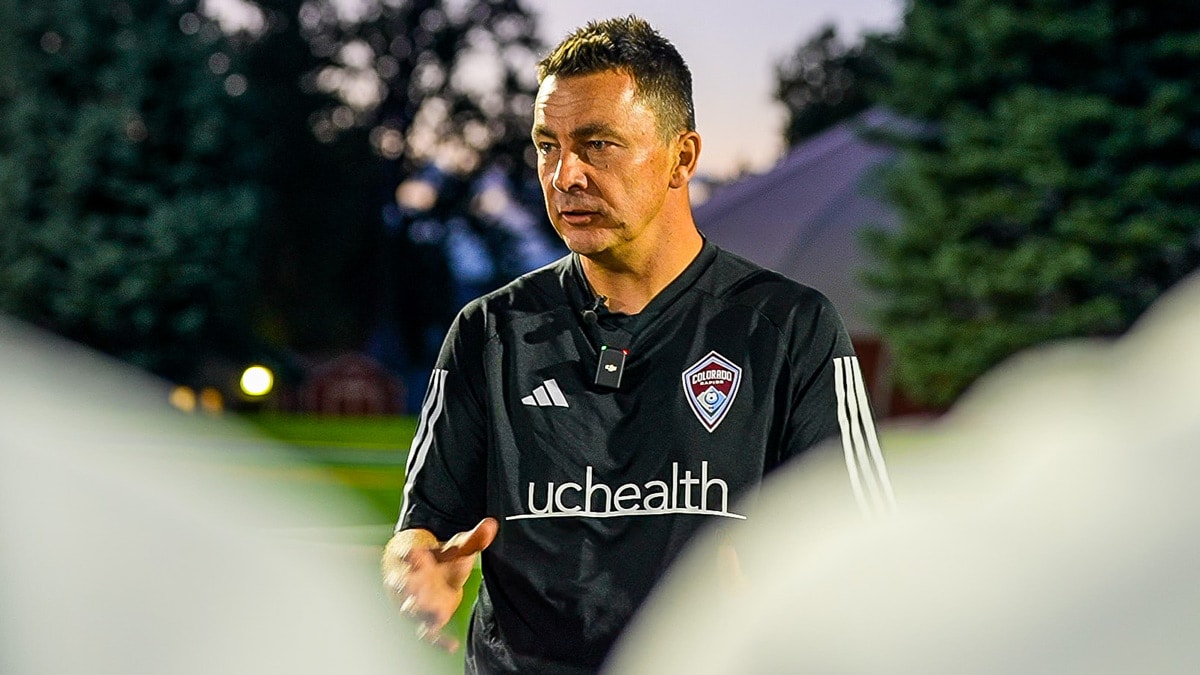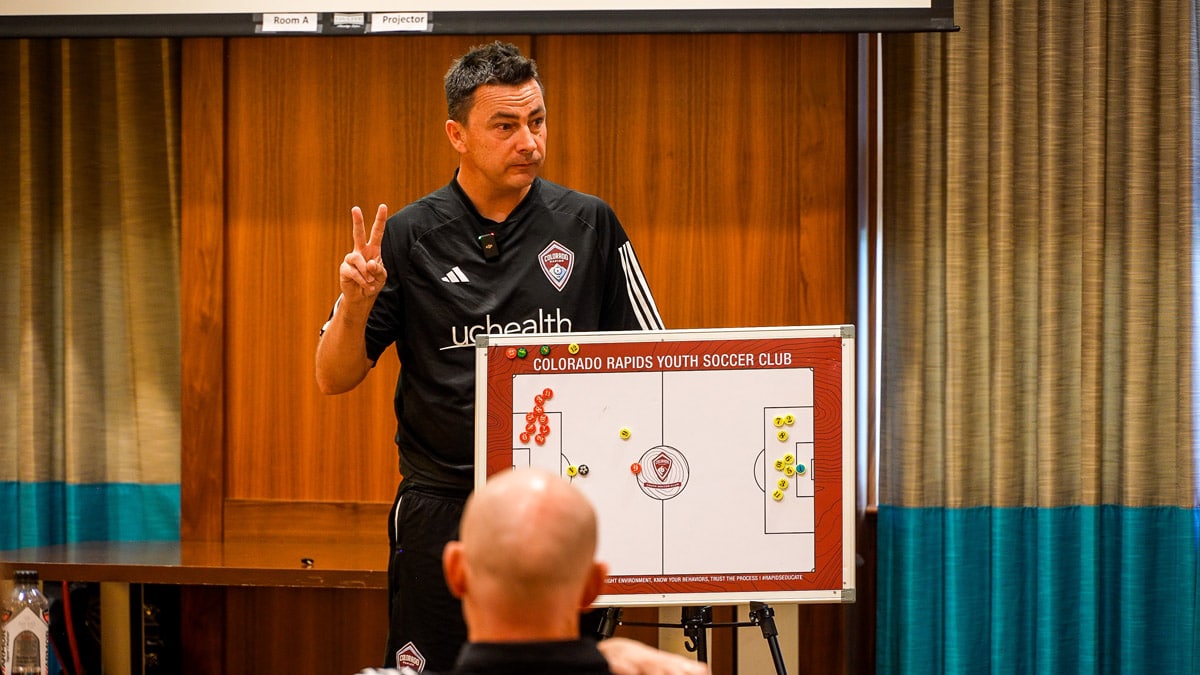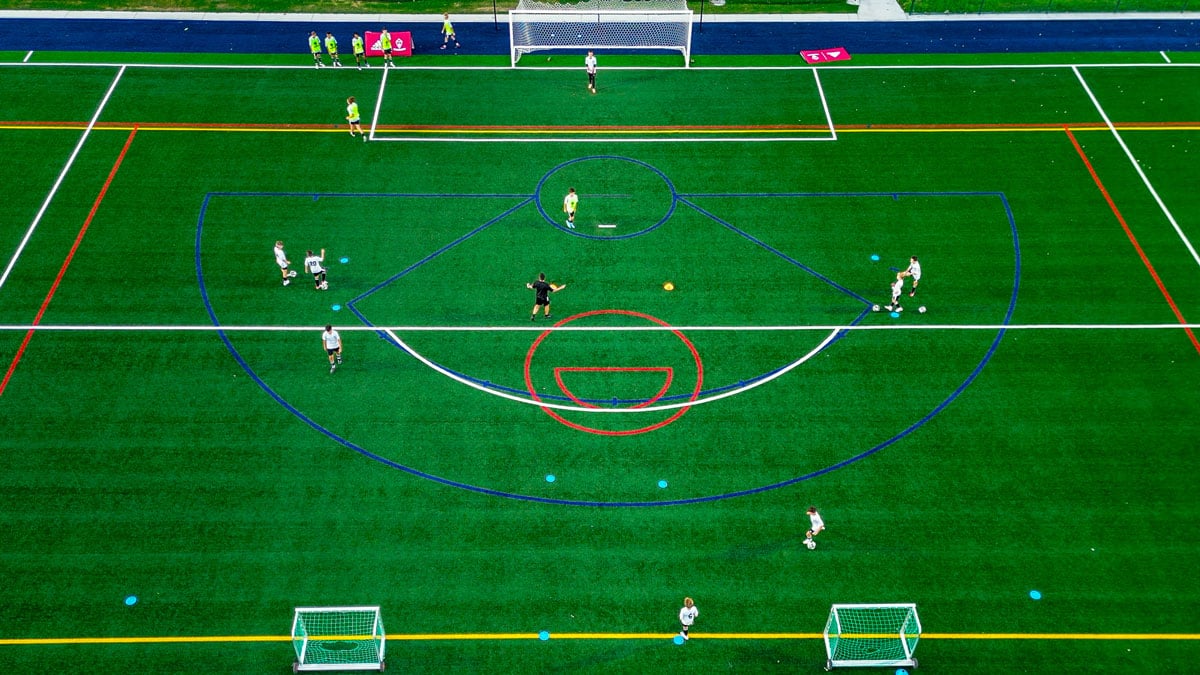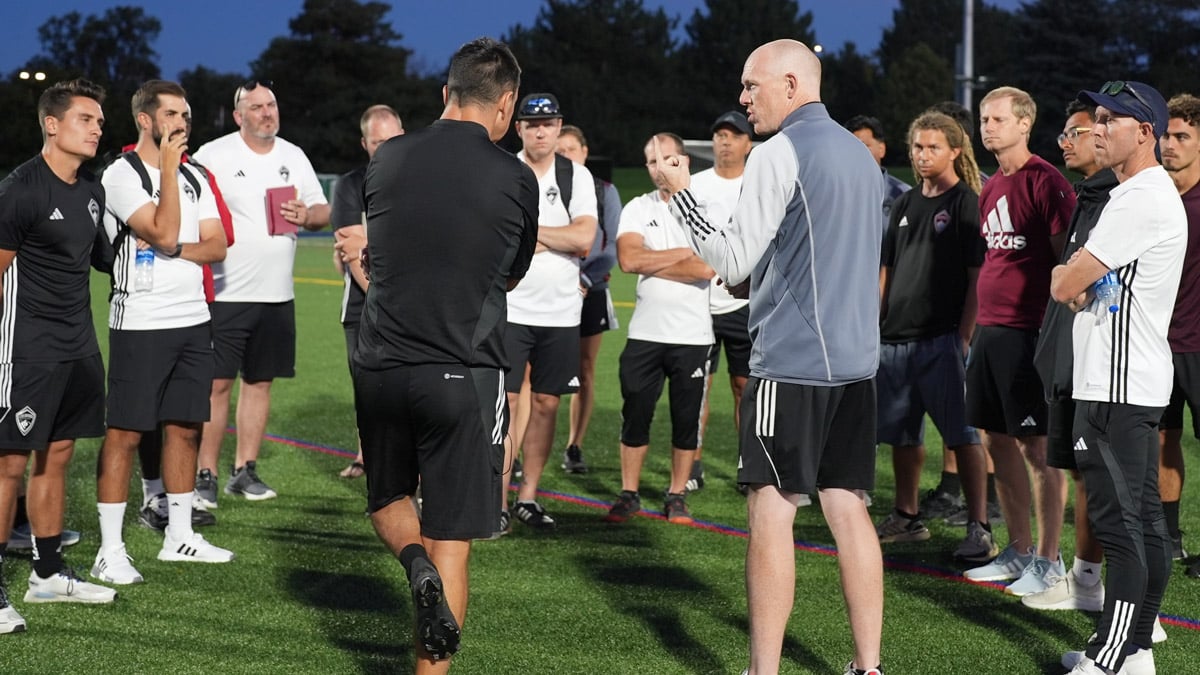
“Teams don’t learn. Individuals within the team learn. Development is a personal process, even when conducted in a team environment.” – Johan Cruyff
This September, Colorado Rapids Youth Soccer Technical Director Donald Gillies was joined by Colorado Rapids Interim Head Coach Chris Little to lead a coaches education session and reaffirm the youth club’s commitment to its mission statement of Developing Remarkable Coaches. The topic Chris chose was “The Individualization of Coaching the Player within the Collective”.
“Coaching and planning for the needs of the individual within any specific theme often gets overlooked for the team principle or sub-principle. In discussing the content for the session, Chris described his approach to how he does this, and the value in sharing this with the club coaches was obvious. Sometimes, in searching for educational opportunities, it is the complex systems and themes that gain the most attention, when in reality, simple thoughts and processes executed based on the needs of key individual players can be most effective. Chris’ topic wasn’t simple, but breaking it down to share his methodology in the classroom, he was able to create really impactful pictures on the field,” noted Donald in an overview of the event.
In his presentation, Chris used the Johan Cruyff quote above to set the scene for the youth club coaches who had joined us at Regis University. The quote and the topic “The Individualization of Coaching the Player within the Collective” helped frame the education session, which was then delivered within the context of the practical topic ‘The Creation and Use of Space’.
In essence, Chris used the session to illustrate how we, as coaches, could and should consider the role of the player (singular) in the moment.
- What are the demands on the individual?
- What are the different situations that a player can receive the ball when looking to create and use space?
- What is it that the game is giving us?
- What is the success criteria?
- How is connected to the sub-principle, principle, team values, and identity?
Chris told attendees that “even the best coaches should know that the ability of the player to comprehend and consistently execute more than three elements during the session is very difficult. Choosing one, two, or three specific pieces of focus for the player, based on pre-determined planning, should be the objective, but ultimately, you must coach what the game gives you. If it demands that the coach pays attention to helping the player receive the ball with their back to goal, then that should be where the focus should be. That includes making sure that defenders are doing their job and behaving in the exact way they would in the game. If my session is on ‘creation and use of space’, then the defenders must be good at denying space! It must be game realistic.”
Chris would go on to talk about his methodology being applied to the right circumstances. For example, is the coach working with individual skills isolated for the player, or is a ‘line’ of the team (e.g. midfield), or is it the whole team unit?

Individual – Line – Unit
Whatever the case may be, the content must be based on the vision, style of play, principles, and curriculum the club determines is going to represent the team.
“In my time in North Carolina, 80% of our curriculum was based on the creation and use of space. I believe it is fundamental to how the game works and provides the players and team with the best opportunity to be successful.”
Chris’ insight is a reminder of the famous quote from Xavi:
“I spend the entire 90 minutes looking for space. I’m always between the opposition’s two holding midfielders, I’m thinking, ‘The defense is here, so I get the ball and go there, to where the space is.”
He described that the direction of the club should determine how the coach then works with the players, irrespective of whether it’s individually, within the collective, or both. Once that plan for developing the player is established, the focus can then be on what the environment is like.
Chris is currently working, and has been for a while now, with some of the most talented youth and senior professionals in the U.S.; however, he also shared that he has been in the Youth Club coach position as Director of Coaching at NC Fusion and is emphatic that the creation of the “high-performance environment” has a major impact on the success of the player at any level of play.
He works through a cycle of knowing that every session he delivers should include all or be a blend of these factors;
Inspire – Aspire
Fun (Competition based – Variety – Games based),
Engage – Challenge – Support – Provoke Questions
A place to make mistakes > Learn > Analyze
For a coach to consider all these elements in a single moment is indicative of someone who is another level of practitioner, someone who is at the point in his/her coaching career where these factors are second nature to see, feel, and hear during their session. All of us attending his session could see that Chris has gained that expertise throughout his career. His knowledge and application of that knowledge helped demonstrate his absolute control of an unpredictable environment.
However, the hard work of ensuring that the environment contains those components shouldn’t be reserved for those with experience but can be accounted for in the planning stage.
- Are the practices selected appropriate for ability and age?
- Are they engaging enough?
- If they aren’t, what changes could I prepare to constrain and challenge more?
- Am I comfortable with the players being uncomfortable?
Chris talked through his practical content and showed a video of the Rapids 1st team doing their activities before the session was taken to the field. He noted that while the execution may be at MLS level, the 2010 ECNL boys team who were about to be the on-field pieces for the session ‘should be able to execute 90% of what I’m going to give them, but they will be challenged’.
At one specific part of the session where he was talking them through a specific progression of the technical drill, the movement on and off the ball became complex. As he was working between two groups, when he walked away from his demo players, the activity quickly stalled with confusion. The visible murmuring of the coaches observing was evident and should a collective speech bubble have popped up from the sidelines it would have read “no way are they getting this!”.
As time progressed, the self-regulation of the players took over with leaders emerging, followers listening, and supporters encouraging, to a point where the practice very much resembled what Price, Wilson, Rubio, and others were doing at DSGP. Credit to the players for their perseverance, but certainly the point of the coach being ready to let them fail, to a degree, while still being in control of the environment was a standout moment.
The final element Chris described as a key ingredient in the process, and where the coach really must “go to work”, is in the application.
- The coach has the club’s vision, style of play, and curriculum.
- He/She knows the tenets of the environment they want to create.
- Now, they must apply the planning, content, and corrections to the players in the way it was designed.
The player’s response to the session should be a “real-time” process of…

Analyze – Learn – Practice – Perform
Chris’ role is to be involved in the promotion of that cycle for the player.
- What does the movement look like?
- Could it be more successful like this?
- Where could that 1st touch take you?
- It should look more dynamic than that.
- That’s important movement; don’t forget about it.
Chris’ theoretical content into the practical flowed with incredible ease, and the detail that the coaches observed was excellent, matched in its simplicity. The best part of an education session, aside from what the coaches are observing, should be the internal monologue or conversation with your fellow coach.
- How can that work for me?
- Is he considering position-specific profiles?
- What does he think success looks like?
- That’s too difficult for my players, but I could simplify it by doing this…
The feeling, as Chris wrapped up and we asked questions about his session, was that we could watch and listen to him for far longer than the facility would allow! The concept of coaching the “individual in the collective” is not something that we, as coaches, often fully focus on. A final takeaway was how we could be more deliberate in the planning process for what the demands are on the player and what success would look like supporting the “individual”, “line”, or “unit”.
As a club, we continue to work to provide clarity of the vision, philosophy, and methodology from our Player Development Plan (PDP) that supports your own success as Rapids Youth Club coach. Thank you to those who joined us this September, and we invite all coaches to review the recording of the session here!

Colorado Rapids Youth Soccer Club (CRYSC) serves approximately 10,000 players ages three through 19, beginner to elite, in year-round leagues, camps, and tournaments. As a recognized 501(c)(3) nonprofit organization, CRYSC has been named a top 15 youth soccer club in the U.S. by Soccerwire and the top youth soccer club in Colorado by Colorado Parent Magazine. CRYSC’s mission is to provide an environment where young soccer players from diverse backgrounds are guided and inspired to reach their full potential, both on and off the field.









